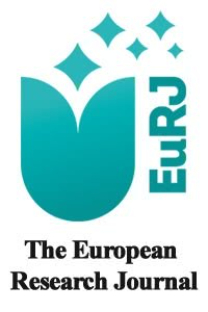Analgesic efficacy and safety of epidural and paravertebral blocks in thoracotomy surgery
Analgesic efficacy and safety of epidural and paravertebral blocks in thoracotomy surgery
Epidural block, paravertebral block, postoperative pain, chronic pain,
___
- 1. Yeung JH, Gates S, Naidu BV, Wilson MJ, Smith FG. Paravertebral block versus thoracic epidural for patients undergoing thoracotomy. Cochrane Database Syst Rev 2016;2:CD009121.
- 2. Arends S, Böhmer AB, Poels M, Schieren M, Koryllos A, Wappler F, et al. Post-thoracotomy pain syndrome: seldom severe, often neuropathic, treated unspecific, and insufficient. Pain Rep 2020;5:e810.
- 3. Marshall K, McLaughlin K. Pain management in thoracic surgery. Thorac Surg Clin 2020; 30:339-46.
- 4. Scarci M, Joshi A, Attia R. In patients undergoing thoracic surgery is paravertebral block as effective as epidural analgesia for pain management? Interact Cardiovasc Thorac Surg 2010; 10:92-6.
- 5. D’Ercole F, Arora H, Kumar PA. Paravertebral block for thoracic surgery. J Cardiothorac Vasc Anesth 2018;32:915-27.
- 6. Feray S, Lubach J, Joshi GP, Bonnet F, Van de Velde M;PROSPECT Working Group *of the European Society of Regional Anaesthesia and Pain Therapy. PROSPECT guidelines for video-assisted thoracoscopic surgery: a systematic review and procedure-specific postoperative pain management recommendations. Anaesthesia 2022;77:311-25.
- 7. Park SK, Yoon S, Kim BR, Choe SH, Bahk JH, Seo JH. Pre-emptive epidural analgesia for acute and chronic post-thoracotomy pain in adults: a systematic review and meta-analysis. Reg Anesth Pain Med 2020;45:1006-16.
- 8. Davies RG, PS Myles, Graham J. A comparison of the analgesic efficacy and side-effects of paravertebral vs epidural blockade for thoracotomy -- a systematic review and meta-analysis of randomized trials. BJA: Br J Anaesth 2006;96:418-26.
- 9. Mohta M, Ophrii EL, Sethi AK, Agarwal D, Jain BK. Continuous paravertebral infusion of ropivacaine with or without fentanyl for pain relief in unilateral multiple fractured ribs. Indian J Anaesth 2013;57:555-61.
- 10. Grider JS, Mullet TW, Saha SP, Harned ME, Sloan PA. A randomized, double-blind trial comparing continuous thoracic epidural bupivacaine with and without opioid in contrast to a continuous paravertebral infusion of bupivacaine for post-thoracotomy pain. J Cardiothorac Vasc Anesth 2012;26:83-9.
- 11. Baidya DK, Khanna P, Maitra S. Analgesic efficacy and safety of thoracic paravertebral and epidural analgesia for thoracic surgery: a systematic review and meta-analysis. Interact Cardiovasc Thorac Surg 2014;18:626-35.
- 12. Ng A Swanevelder J. Pain relief after thoracotomy: is epidural analgesia the optimal technique? Br J Anaesth 2007;98:159-62.
- 13. Markham T, Wegner R, Hernandez N, Lee JW, Choi W, Eltzschig HK, et al. Assessment of a multimodal analgesia protocol to allow the implementation of enhanced recovery after cardiac surgery: retrospective analysis of patient outcomes. J Clin Anesth 2019;54:76-80.
- 14. Batchelor TJ, Rasburn NJ, Abdelnour-Berchtold E, Brunelli A, Cerfolio RJ, Gonzalez M, et al. Guidelines for enhanced recovery after lung surgery: recommendations of the Enhanced Recovery After Surgery (ERAS®) Society and the European Society of Thoracic Surgeons (ESTS). Eur J Cardiothorac Surg 2019;55:91-115.
- 15. Asban A, Xie R, Abraham P, Kirklin JK, Donahue J, Wei B. Reasons for extended length of stay following chest tube removal in general thoracic surgical patients. J Thorac Dis 2020; 12:5700-8.
- 16. Cerfolio RJ, Bryant AS, Skylizard L and Minnich DJ. Optimal technique for the removal of chest tubes after pulmonary resection. J Thorac Cardiovasc Surg 2013;145:1535-9.
- 17. Terkawi AS, Tsang S, Sessler DI, Terkawi RS, Nunemaker MS, Durieux ME, et al. Improving analgesic efficacy and safety of thoracic paravertebral block for breast surgery: a mixed-effects meta-analysis. Pain Physician 2015;18:E757-80.
- 18. Scholz J, Finnerup NB, Attal N, Aziz Q, Baron R, Bennett MI, et al. The IASP classification of chronic pain for ICD-11: chronic neuropathic pain. Pain 2019;160:53-9.
- ISSN: 2149-3189
- Yayın Aralığı: 6
- Başlangıç: 2015
- Yayıncı: Prusa Medikal Yayıncılık Limited Şirketi
Evaluation of optic nerve by histogram analysis on MRI in patients with isolated optic neuritis
Seda Nida KARAKÜÇÜK, Adil DOĞAN, Murat BAYKARA, Selma URFALIOGLU
Efficacy of topical mineralocorticoids in a rabbit model of ocular inflammation
Asli VURAL, Oguz DİKBAS, Selahattin VURAL, Hümeyra BOZOĞLAN, Bircan SÖNMEZ
Orhan GÜVENÇ, Mesut ENGİN, Irem Iris KAN, Senol YAVUZ
Mothers' perspective on human papillomavirus vaccine in Eastern Turkey
Ülkü Ayşe TÜRKER ARAS, Samet KIRAT, Ozge YENDUR, Ayşe Ender YUMRU
Çetin TURAN, Abdullah KÜÇÜKALP
The relationship between sustainable nutrition and healthy food choice: a cross-sectional study
The prognostic implications of a fragmented QRS pattern in patients diagnosed with heart failure
Ahmet DEMİRKIRAN, Mustafa YİLMAZ, Ömer ŞİT, Adem ATICI, Hasan BARMAN
Pulmonary and cardiac involvement in patients with rheumatoid arthritis and ankylosing spondylitis
